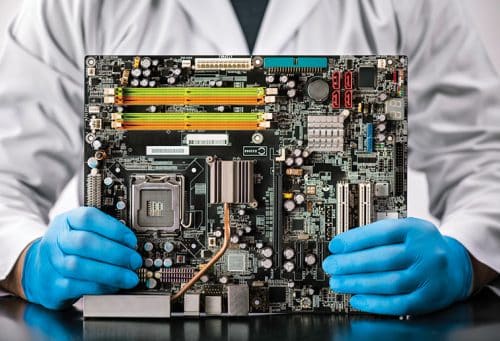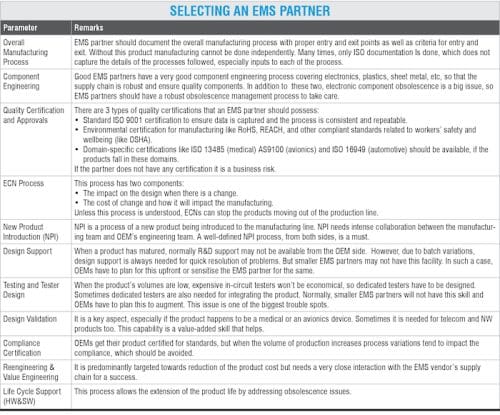With the outsourced manufacturing becoming a norm in electronics product manufacturing, one of the key aspects that needs to be addressed is the choice of electronics manufacturing service (EMS) provider. When an OEM looks for outsourcing their manufacturing, deciding what to outsource is only 50% of the solution and the other 50% is to decide whom to outsource to. This step is always a challenge. One wrong move at this stage destroys the relationship with their client and the business for the OEMs
Most of the times lower cost seems to be the primary driver for selecting the EMS partner. But this can be risky as a successful EMS partnership is based on much more than the cost alone. The best way to assess an EMS partner is to do a capability map exercise, which is basically assessing the processes involved around the manufacturing and see mutually where the OEM and the different EMS partners stand. This helps the OEM to take a considered decision based on facts and capabilities and not based on cost alone.
When deciding to outsource, OEMs have to be clear about what to outsource. Some of the key aspects seen over time are;
- OEMs have to identify their core competency and outsource what is not theirs. Unfortunately, most of the times it is the other way round! One classic example is of an RF product manufactured by an OEM where the process of tuning needed intimate knowledge of the system, so complete outsourcing was not done. Instead, they did the final assembly in-house rather than outsourcing due to the complexity involved, and the product was a success.
- Manufacturing cost alone cannot be the driver for outsourcing. Costs of transport, higher inventory levels due to distance and lead times, parts to be stocked for warranty, test and repair have to be factored in deciding the EMS partner.
- This is critical if the product is for a global market. As even the shipment packaging has to meet stringent standards. A well-planned product design and outsourcing strategy helps to a great extent.
- Mature products with predictable schedules are the best candidates for outsourcing most of the times.
- However, OEMs have to be aware of some of the risks like quality of components, impact of volume variations, and confidentiality when outsourcing their product for production. While most EMS partners adhere to rules, mistakes do happen due to business pressures.
- Also, on the commercial side, OEMs need to factor in the local tax structure as mostly manufacturing units enjoy some kind of incentives; unless OEMs understand that, EMS partners may not share them.
- Financial stability and credit practices of a EMS partner is paramount, as when an EMS partner gets into financial trouble the inventories get locked up and OEMs’ business suffers due to the sudden event.

What to look for when selecting an EMS partner
As mentioned earlier, choosing an EMS partner is not a transaction that you can do once. OEMs have to continuously spend time, energy, and money to maintain the relationship. The best approach is to select an EMS partner with whom you can stay for a long time.
Many times, when you work with smaller EMS partners, you end up training them, and this calls for investment in time and money. But this has to be treated as an ‘investment’ as the benefits are many and lead to strengthening of the relationship.
SMEs and startups tend to change their EMS partners based on the cost and other considerations, disregarding the need for a stable relationship. The operations teams of such OEMs go through huge pain in adjusting to the new EMS partners. So, changing the EMS partner should be avoided as far as possible.
Some key aspects that the EMS partners should possess are given in the table with a brief explanation. Actually, the real process has a large check-list and OEMs need to spend lot of time to evaluate the EMS partner. Above all, the OEMs should treat outsourcing “not as a throw it over the wall” approach and need to do lots of handholding. Lot of discipline is needed in the design phase. Also, documentation needs to be perfect for a product to be successfully manufactured.

Tips for designing products for outsourced manufacturing
Having seen the importance of an EMS partner, critical aspects in electronics manufacturing, and what to look for when selecting an EMS partner, let us see what aspects the designers need to take care of to make the design suitable for outsourced manufacturing.
1. First aspect is the experience of the EMS partner, like how long they have been in the business, their experience in the domain you are in, infrastructure (what is the age of machinery), locations, backward integrated manufacturing capabilities (like in-house magnetics, enclosures, plastics, and cables and harnesses).
2. Ability of the EMS partner to provide different types of services like:
- Just board assembly.
- Complete product manufacturing (known as box build). The OEM has to give only the documentation and training to test the product. EMS partner will do rest of the work.
- Warranty, test, and repair. Many EMS partners offer this service, which helps the OEM to offer warranty and repair services for the products without really worrying about setting up their own.
- ODM services. EMS partners like Foxconn, Acton, and Sanmina offer full products designed and manufactured by them. OEMs can put their labels and sell them. These are called ‘white labeled’ products. For example, Foxconn group company Quanta designs laptops that are labeled and sold by many PC vendors. Similarly, Sanmina sells carrier-grade servers designed by their team, while Acton offers networking products as white labeled products.
3. If your product is a medical or avionics device, ensure that apart from ISO13485 certification your EMS partner has IT infrastructure to support device manufacturing records (DMRs) in a safe place, till the product is withdrawn from the market. Basic idea is that, if there is a failure in the field, these DMRs enable to analyse the records and identify any component or process failure that may have occurred.
4. EMS partner should provide the designers with DFx (where x stands for assembly, manufacturing, testing, compliance, or environment) guidelines and checklists, so that the designers can design the systems and the PCB as per those standards. This enables smooth transition from the development lab to manufacturing line.
5. Ensure that the EMS partners follow environmental compliant processes and materials. Basically, they should ensure lead-free soldering (known as RoHS) and REACH (detailed composition of materials used). The compliance should cover not only the manufacturing process but also aspects impacting employees’ health like OSHA (Occupational Safety and Health Administration) standards, which deal with the employees’ working environment, lighting, seats and workbenches, and tools that are used in the process.
6. Get to know the inventory turn of the EMS partner. Inventory turn is a measure of how many days the EMS partner takes to convert components that enter the factory to finished products that are shipped out. Inventory turn of 10-12 days is considered to be good. If more days are taken, it is considered inefficient.
7. Another key aspect is the test engineering capability. A large-volume product needs both PCB and system testers, which are expensive but at the same time decide the quality of the product. EMS partner should have a very good test infrastructure and good test engineers to manage it.
8. Logistics (both forward and reverse) is also an important capability of the EMS partner, as EMS partners use contracted vendors for the same and many times do not take the responsibility for the transit damage. So a robust logistics is a must for an EMS partner’s success.
9. Understand how the employees are trained in the overall process, their orientation to quality, and the process they use to get their employees trained in your products. Most of the time there is a blackhole where things drop and disappear!
10. Finally, the employee relationship and industrial relationship has to be good and no dispute should be visible. This is a key condition which is essential for a successful manufacturing relationship.
S.A. SRINIVASA MOORTHY is Director Engineering Design, D4X Technologies Pvt Ltd






